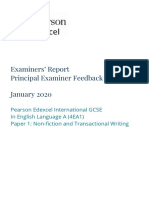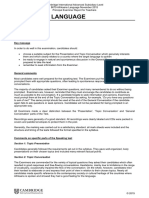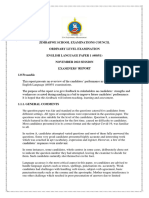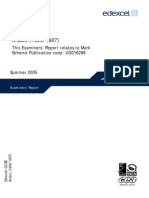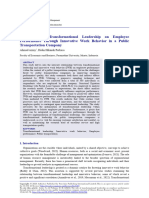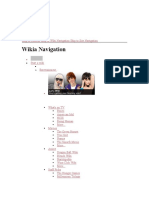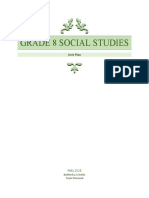Aqa - Eng1f & Eng1h - Wre - Jan 2011-1
Aqa - Eng1f & Eng1h - Wre - Jan 2011-1
Uploaded by
abaine2Copyright:
Available Formats
Aqa - Eng1f & Eng1h - Wre - Jan 2011-1
Aqa - Eng1f & Eng1h - Wre - Jan 2011-1
Uploaded by
abaine2Copyright
Available Formats
Share this document
Did you find this document useful?
Is this content inappropriate?
Copyright:
Available Formats
Aqa - Eng1f & Eng1h - Wre - Jan 2011-1
Aqa - Eng1f & Eng1h - Wre - Jan 2011-1
Uploaded by
abaine2Copyright:
Available Formats
Version 1.
General Certificate of Secondary Education January 2011
English/English Language
ENG1F ENG1H
(Specification 4700 & 4705) Unit 1: Understanding and producing nonfiction texts (Foundation & Higher Tiers)
Report on the Examination
Further copies of this Report on
the Examination are available from: aqa.org.uk
Copyright 2011 AQA and its licensors. All rights reserved. Copyright AQA retains the copyright on all its publications. However, registered centres for AQA are permitted to copy material from this booklet for their own internal use, with the following important exception: AQA cannot give permission to centres to photocopy any material that is acknowledged to a third party even for internal use within the centre. Set and published by the Assessment and Qualifications Alliance.
The Assessment and Qualifications Alliance (AQA) is a company limited by guarantee registered in England and Wales (company number 3644723) and a registered charity (registered charity number 1073334). Registered address: AQA, Devas Street, Manchester M15 6EX.
Report on the Examination General Certificate of Secondary Education English Language Unit 1: Understanding and producing non-fiction texts (higher) January 2011
English Language Unit 1 ENG1F Introduction
It was pleasing that so many candidates were able to cope with the format of the examination paper. Thank you to centres who were mindful of the fact that scripts were to be scanned for the first series of online marking in English. It would be advisable for examinations officers to remind candidates to adhere to instructions with regard to writing within the parameters of the box and to avoid writing additional parts to an answer in separate places in the answer booklet as each questions is marked as a whole item by different examiners. It was also pleasing that so many Foundation candidates were able to cope with the length of the paper and the transition to two writing tasks in the time. Questions 1 3 specifically address English AO2i and English Language AO3i Read and understand texts, selecting material appropriate to purpose Question 1 On the whole this simple select/retrieval task did not pose problems for many candidates. The Jamie Oliver source seemed to allow candidates to access the required information with ease and achieving 3 or 4 marks here was the norm. Some candidates however, wrote down any four things from the article without paying close regard to the question, which asked specifically for things connected to healthier school meals. It would also be useful in practice work to encourage students to list with clarity perhaps using a format such as: We learn: and enabling students to finish off the sentences so their responses are clear for the examiners. Question 2 Most candidates were able to locate the key reaction that Jamie Oliver felt the results were fantastic. However, centres might note that on the mark scheme, a grid is utilised to mark this question on the basis of skills. Here, the Read and understand part of the AO becomes important. Candidates achieving full marks here were those who were able to cite two or more of Olivers reactions, offer quotation and make inferences about them.
Question 3 Question 3 was much more problematic and really showed a lack of experience and preparedness for many candidates, which was surprising given that this was, in effect, a straightforward comprehension question. For some, seeing the charity advertisement led them to conclude that they should answer the question from the specimen paper and they addressed language issues rather than reasons. Question 3 is an 8 mark question which again consolidates skills in AO2i/AO3i and the mark scheme represents each aspect of the AOs, asking for evidence of understanding and inference to achieve full marks in Band 2 and beyond. Many candidates, despite locating the key reasons, tended to copy them out verbatim rather than using them as supporting quotations, which made it impossible to reward them for inference. Questions 4 and 5 deal specifically with English AO2iii and English Language AO3iii Explain and evaluate how writers use linguistic, grammatical, structural and presentational features to achieve effects and engage and influence the reader. Question 5 additionally tests on, making comparisons and cross references as appropriate.
Report on the Examination General Certificate of Secondary Education English Language Unit 1: Understanding and producing non-fiction texts (higher) January 2011
Question 4 Question 4 will always ask candidates to comment on features of language. However, this was problematic for the majority of candidates, many of whom did not seem to have a toolkit to enable them to comment on language features and their effect. Some candidates attempted to describe the language of the text as a whole, the leaflet informs us by using informative language but the majority simply regurgitated the content of the text. Many others were unsure of the distinction between language features and presentational features. This was saddening because in the Section B, candidates had clearly been prepared with numerous techniques to use imperative verbs, rhetorical questions, emotive language, opinions and statistics and yet, could not transfer their skills to be able to comment on specific language features for question 4. Centres would be advised to look closely at the indicative content of the mark scheme for question 4 to help prepare candidates for future series. This was clearly the weakest area of the paper with few candidates making it out of Band 1. Question 5 As mentioned above, Question 5 is comparative and on Foundation Tier will always ask candidates to comment on and compare the presentational features of two out of the three texts. Candidates were more confident with dealing with presentation, though some again, blurred the distinction between language features and presentational features. However, it was pleasing to see candidates across the ability range attempting to make meaningful comments on the images and structure of the texts and especially pleasing to see some candidates commenting on the connotations of colours and images, linking their ideas to the content of the text. This was done especially well on the Sponsor A Girl text. Simple comparisons and cross references were made by most candidates, though some developed ideas were pleasing, particularly those who commented on the realism and seriousness of the photographs in Source 2 compared to the humour of the cartoons in Source 3. Question 6 The letter-writing task was generally well handled and candidates responded with enthusiasm. Some had clearly practised writing to inform and were determined to inform, though the task itself asked for explanation. Those who did engage with the required purpose were able to choose two or three key areas for improvement and explain in detail their reasons why. These letters were much more successful and engaging and able to move into Band 3. Less successful were the list like responses which were then very limited with regard to purpose. Most candidates were able to structure the letters in a conventional format, though a surprising number wrote in a rather inappropriate register for their head teacher, with cheery salutations such as Hello and Hiya. Nevertheless, this task was well handled by the majority. One area of concern was that some of the letters were lengthy and bearing in mind the weighting of the writing questions, this may have disadvantaged some candidates from performing as well on the more developed response required for Question 7.
Question 7 The charity leaflet task clearly engaged candidates who were well prepared and practised. They wrote engaging and at times emotive texts, employing a whole range of persuasive language features. These were a pleasure to read. Their success was also due to the fact that they chose a specific event such as a Fun Run or a Cycle Ride. Less successful were those who wrote informative, promotional responses for Fetes and Funfairs, which did not closely match the task or the purpose or indeed the audience. Other students relied heavily on the source material and did not respond to the word event in the question. Their requests for monthly donations for a specific charity meant that the purpose was addressed but not the task and that the links to audience were tenuous. On a general note, however, it was clear that there was a certain degree of immaturity in many of the responses. Though this is to be expected with a new modular examination, it did seem that most candidates would have benefitted from more teaching of the actual new specification and more experience and expertise in both the comprehension of non fiction texts and their creative production before being required to sit their public examination in the subject.
Report on the Examination General Certificate of Secondary Education English Language Unit 1: Understanding and producing non-fiction texts (higher) January 2011
ENG1H Introduction
The senior examiners have reported that candidates did not encounter difficulties in accessing the question paper, including the reading source materials. There were no reported problems with the level of reading required, the source materials were presented in a clear manner. The format of the paper followed that of the specimen paper very closely. The word count was some 50 words shorter than that in the specimen paper. The attention of teachers and students is drawn to the benefit of carefully reading the entire question paper including the source materials at least once before commencing the paper. There is a time allowance of 15 minutes built in to the examination for this purpose. Centres are advised that careful training in examination technique is important. Attention is also drawn to the mark weightings attached to the individual questions and sections. Candidates should ensure they allocate their time as appropriate.
Section A: Reading
Question 1 was generally well answered. Most candidates were able to provide a summary of what they had learned from the text source to secure a mark in Band 3. There was often a clear attempt to go beyond simple retrieval and make interpretations of the text, for example deducing, in the candidates own words, some of the writers feelings, or making connections between events, such as noting the benefits of being with different kinds of people. Such aspects as these (which are noted in the mark scheme) are as much part of what is learned from the text as are the various events and experiences reported by the writer. Inferences, comments and connections are features that candidates should be aware of whilst demonstrating a detailed understanding of, and engagement with, the text. The question did not require an analysis of the language techniques employed by the writer and candidates who offered this would have benefited from understanding the specific skills being tested by the question. Question 2 was also, generally, successfully answered. Many candidates examined each of the elements asked for in the question and most related these to the body of the text. Some candidates made rather general or generic points about the function of headlines and sub-headlines and other presentational devices and missed the opportunity to make specific, scoring points about some interesting words and ideas. The effects noted were sometimes mundane but also produced some more original and telling comments such as The picture gave me the chills by a candidate who also explained why. The best responses focused on the contradiction, paradox and irony of the message of the text as exemplified by the apparent fearsomeness of the picture and the words in the headlines. Candidates would benefit from focusing on the individual words, their meaning and effect, as well as the detail within the picture when responding to this type of question. Some candidates, for example, drew inferences about size from the juxtaposition of the huge fossil and the relatively small people looking at it, relating that observation to the size of a pigeon and then linked those interpretations to material in the text. Comments on both presentational and linguistic features in the headlines are expected for this question, as well as detailed, original ideas about the picture. Question 3 was often successfully answered by candidates, particularly those who read the question properly and had read through all of the questions to begin with. These candidates chose, as the question required, the parts of the text which they found tense and exciting and the best gave some original and contextualised reasons. For example, a good explanation for choosing the part where the climbers thought they were going the wrong way would be because it made the reader realize the vastness of the mountain and the possibility of confusion and panic in their desperate situation; a less good explanation would be that it made the reader want to read on to find out what happened. Some candidates responded to this question as if it were a language question. Where the comments fitted specific parts of the text, this was rewarded on a best-fit basis.
Report on the Examination General Certificate of Secondary Education English Language Unit 1: Understanding and producing non-fiction texts (higher) January 2011 Candidates would benefit from practising being able to explain why writing is effective for the reader by making telling, original and perceptive comments related, perhaps, to their own experience or related to other events within the context and content of the text itself. Question 4 was the question with which most candidates had difficulty. There were 16 marks available for this question compared with 8 marks for questions 1,,2 and 3. The reason being that this question tested the candidates ability to compare two texts by analysing the effects of the writers use of language. This was the language question. Examiners reported a number of problems. Sometimes candidates made general remarks about genre, purpose, audience and voice (often confused) without producing effective and succinct examples from the Everest text in support and without finding valid comparative aspects from the chosen text. Where devices were spotted, the comparisons tended to be forced or weak. General comments, for example, about being in the first person, being an article, happening in the present tense or they both use rhetorical questions might have developed into a valid response but often did not. In the best responses, (and those sought by the examiners) candidates selected interesting, vivid, colourful or exciting phrases from the Everest text and unwrapped their meaning and effect. They then found similar (or very different) examples from the chosen text explaining that the difference in language use resided, perhaps, in purpose and audience. Question 4 is designated the language question on this tier for this exam. There is a similar question currently on all of the legacy exam papers. Candidates would benefit from some specific and sustained coaching in the two skills tested here: the analysis of a writers use of language and how to compare the effects of that usage in different texts.
Section B: Writing
Question 5, examiners reported, was clearly enjoyed by candidates and was an enjoyable section of the paper to mark. Many candidates produced interesting and engaging responses that were well structured and demonstrated a capacity to employ a variety of writing devices. However, some issue arose. Some candidates wrote at a length inappropriate for the time and marks available. Some candidates clearly wrote fiction, which did not necessarily preclude a respectable mark, whereas wholly narrative responses which were not focused on aspects of the unusual or memorable, or did not address an interesting journey/experience, did not attain success. There was some very successful and compelling writing from obviously very able candidates. The task required candidates to inform/describe and explain. The challenge for candidates was to achieve those purposes with a piece that was engaging and original, but to achieve it succinctly. Question 6 was a challenge for some candidates but many produced a cogent and clearly thoughtthrough argument. Many successful candidates demonstrated confidence in their views and produced structured, developed and rounded ideas ably expressed. There was no shortage of the moral dimension inherent in the topic: freedom of choice, free-will, independence, the nanny state (or school) often featured as the enemy of those who wished to bungee jump from a cliff top or sky-dive over the arctic. However, there was much which was incomplete, not well constructed, not considered and quite often focused on sport or sport in schools rather than what the task actually required. Some candidates did hedge their bets, asserting that every sport or pastime was dangerous (including ballet), thus widening their canvas with some validity. Many candidates would have benefited from reading the wording of the task carefully and making time for some preliminary thought. Points made by examiners about accuracy were no different from those made at present for current writing tasks in current exams. Other comments included the over-use of the rhetorical question and spurious quasi-statistics which detract from, rather than add to, the effectiveness of the writing. With two writing tasks differently weighted, candidates need advice and practice in timing their different responses to the tasks. There is clear evidence that they are not short of ideas and opinions but these need to be advantageously managed.
Report on the Examination General Certificate of Secondary Education English Language Unit 1: Understanding and producing non-fiction texts (higher) January 2011
In Conclusion
In general many candidates managed the new challenge very well. However, two key points emerged from examiners concerning the exam which would point to future good practice given that the structure of the paper will be replicated in future series. The first is that candidates need to have a strategy for successfully managing the paper, mainly in terms of the allocation of time, particularly for the Writing section but also by using the reading time to full advantage. Secondly, because each of the questions is related to specific skills, candidates need to know what each of the skills is and be taught them. In this January series, the first of these points would have helped candidates generally, but particularly those who had something to say for Question 6 but had no time to say it. The second point was particularly pertinent for Question 4 which many candidates were unable to undertake with much success.
Mark Ranges and Award of Grades
Grade boundaries and cumulative percentage grades are available on the Results statistics page of the AQA Website.
You might also like
- Primer On Market ProfileDocument4 pagesPrimer On Market Profilechalasanica100% (2)
- Examiners' Report June 2019: IGCSE English Language 4EB1 01Document52 pagesExaminers' Report June 2019: IGCSE English Language 4EB1 01English TeacherNo ratings yet
- How to Reach the 9.0 in IELTS Academic ListeningFrom EverandHow to Reach the 9.0 in IELTS Academic ListeningRating: 4.5 out of 5 stars4.5/5 (7)
- Nataraja TempleDocument74 pagesNataraja TempleudayNo ratings yet
- Examiners' Report Principal Examiner Feedback January 2020Document10 pagesExaminers' Report Principal Examiner Feedback January 2020Noël PereraNo ratings yet
- 4eb1 01 Pef 20230824Document65 pages4eb1 01 Pef 20230824Heena MeahNo ratings yet
- Examiner Report Jan 2019 4EB1Document12 pagesExaminer Report Jan 2019 4EB1JerryNo ratings yet
- Examiner Report Jan 2018Document10 pagesExaminer Report Jan 2018JerryNo ratings yet
- Examiners' Report Principal Examiner Feedback January 2019Document11 pagesExaminers' Report Principal Examiner Feedback January 2019Mie NgeNo ratings yet
- Examiners' Report/ Principal Examiner Feedback June 2011: International GCSE Spanish (4SP0) Paper 2Document8 pagesExaminers' Report/ Principal Examiner Feedback June 2011: International GCSE Spanish (4SP0) Paper 2EinsteinNo ratings yet
- IGCSE English Language B - Examiner Report-Paper1 - January 2012Document7 pagesIGCSE English Language B - Examiner Report-Paper1 - January 2012harunxNo ratings yet
- Foreign Language Indonesian: Paper 0545/02 Reading and Directed Writing Key PointsDocument9 pagesForeign Language Indonesian: Paper 0545/02 Reading and Directed Writing Key PointsBrytistaNo ratings yet
- English As A Second Language (Speaking Endorsement)Document27 pagesEnglish As A Second Language (Speaking Endorsement)naderipop2006No ratings yet
- CSS-2015 Examiner Report FinalDocument45 pagesCSS-2015 Examiner Report FinalAsad Ullah100% (1)
- Examiners' Report: Principal Examiner FeedbackDocument8 pagesExaminers' Report: Principal Examiner FeedbackRafaNo ratings yet
- 4eb1 01r Pef 20220825Document57 pages4eb1 01r Pef 20220825Heena MeahNo ratings yet
- Examiners' Report Principal Examiner Feedback January 2020Document9 pagesExaminers' Report Principal Examiner Feedback January 2020Noël PereraNo ratings yet
- Afrikaans Language: Paper 8679/01 SpeakingDocument8 pagesAfrikaans Language: Paper 8679/01 SpeakingMudassir KhanNo ratings yet
- O Level English 400501 Nov22Document7 pagesO Level English 400501 Nov22annahlorah01No ratings yet
- 0500 s02 ErDocument15 pages0500 s02 ErTao FanNo ratings yet
- 4EB0 01 Pef 20180822Document11 pages4EB0 01 Pef 20180822sophie atkensNo ratings yet
- Waa01 01 Pef 20220818Document6 pagesWaa01 01 Pef 20220818grengtaNo ratings yet
- 2011 Aqa Gcse English Language Foundation)Document14 pages2011 Aqa Gcse English Language Foundation)chanyt17No ratings yet
- VCE English Language 2016-2021: School-Assessed Coursework ReportDocument5 pagesVCE English Language 2016-2021: School-Assessed Coursework Reportdinho91No ratings yet
- Examiners' Report - Paper 3 - October 2020Document5 pagesExaminers' Report - Paper 3 - October 2020tiranbaskaya07No ratings yet
- 03 0510 0511 0991 0993 FOA2 Key PERTDocument2 pages03 0510 0511 0991 0993 FOA2 Key PERTthargyimiengeNo ratings yet
- General PaperDocument3 pagesGeneral Papermrustudy12345678No ratings yet
- English 0500 m21 ErDocument27 pagesEnglish 0500 m21 ErSweet ConnectionzNo ratings yet
- 0539_s19_erDocument7 pages0539_s19_erbreshnaimran321No ratings yet
- Afrikaans Language: Paper 8679/01 SpeakingDocument3 pagesAfrikaans Language: Paper 8679/01 SpeakingMudassir KhanNo ratings yet
- English As A Second Language (Speaking Endorsement)Document26 pagesEnglish As A Second Language (Speaking Endorsement)Thinzar Tin winNo ratings yet
- Examiners' Report: Principal Examiner FeedbackDocument7 pagesExaminers' Report: Principal Examiner FeedbackRafaNo ratings yet
- Examiners' Report Summer 2007: GCSE Russian (1241)Document15 pagesExaminers' Report Summer 2007: GCSE Russian (1241)minnie murphyNo ratings yet
- English As Second Language StudiesDocument5 pagesEnglish As Second Language Studiesdchan_26No ratings yet
- Grade 7 English p2 2022Document8 pagesGrade 7 English p2 2022Kudakwashe MusvaireNo ratings yet
- Examiners' Report/ Principal Examiner Feedback June 2011: International GCSE Bengali (4BE0) Paper 1Document6 pagesExaminers' Report/ Principal Examiner Feedback June 2011: International GCSE Bengali (4BE0) Paper 1murtaza123No ratings yet
- Italian Assessrep 06Document6 pagesItalian Assessrep 06evatangNo ratings yet
- Examiners' Report Principal Examiner Feedback: Pearson Edexcel International GCSE in English Language B (4EB1) Paper 01RDocument14 pagesExaminers' Report Principal Examiner Feedback: Pearson Edexcel International GCSE in English Language B (4EB1) Paper 01RRoy PedersonNo ratings yet
- Examiners' Report Principal Examiner Feedback: Pearson Edexcel International GCSE in English Language B (4EB1) Paper 01RDocument14 pagesExaminers' Report Principal Examiner Feedback: Pearson Edexcel International GCSE in English Language B (4EB1) Paper 01REZNo ratings yet
- Examiners' Report Principal Examiner Feedback January 2018Document9 pagesExaminers' Report Principal Examiner Feedback January 2018RafaNo ratings yet
- May 2013 Subject ReportDocument11 pagesMay 2013 Subject ReportezzNo ratings yet
- 4EA1 01 Pef 20220825Document76 pages4EA1 01 Pef 20220825abdurahman.abdisamedNo ratings yet
- WAA01 01 Pef 20210304Document7 pagesWAA01 01 Pef 20210304grengtaNo ratings yet
- 9aa0 03 Pef 20230817Document6 pages9aa0 03 Pef 20230817memoona amanNo ratings yet
- Edexcel GCSE Arabic (1606/1607) : This Examiners' Report Relates To Mark Scheme Publication Code: UG016288Document16 pagesEdexcel GCSE Arabic (1606/1607) : This Examiners' Report Relates To Mark Scheme Publication Code: UG016288Mohammed SachaNo ratings yet
- Examiners' Report Principal Examiner Feedback January 2020Document12 pagesExaminers' Report Principal Examiner Feedback January 2020hoirace kwokNo ratings yet
- Sac Eslreport FaDocument5 pagesSac Eslreport FaAisha ZykaNo ratings yet
- Jun 2011 Mark Scheme FDocument15 pagesJun 2011 Mark Scheme Fkal1997No ratings yet
- BTTL PP luận nghiên cứu KH. Nguyễn Thị Ái NhungDocument8 pagesBTTL PP luận nghiên cứu KH. Nguyễn Thị Ái Nhungnhung nguyen aiNo ratings yet
- 4EB0 01R Pef 20180822Document9 pages4EB0 01R Pef 20180822andy-cai2005No ratings yet
- 4ea1 01 Pef 20220825Document76 pages4ea1 01 Pef 20220825AidenNo ratings yet
- Cambridge Primary Checkpoint End of Series Report: October 2016Document94 pagesCambridge Primary Checkpoint End of Series Report: October 2016Hildebrando GiraldoNo ratings yet
- Chinese As A Second LanguageDocument6 pagesChinese As A Second LanguageMaryam ShahidNo ratings yet
- June 2021 Examiner ReportDocument64 pagesJune 2021 Examiner ReportThunder StrikeNo ratings yet
- WBS11 01 Pef 20190307Document5 pagesWBS11 01 Pef 20190307Ahmad Rahje0% (1)
- Examiners' Report Principal Examiner Feedback January 2018Document18 pagesExaminers' Report Principal Examiner Feedback January 2018khalid qadirNo ratings yet
- FRENCH (Foreign Language) : Paper 0520/11 ListeningDocument43 pagesFRENCH (Foreign Language) : Paper 0520/11 ListeningTrévina JosephNo ratings yet
- Paper 2 - Night (Report)Document62 pagesPaper 2 - Night (Report)Tuệ AnhNo ratings yet
- 0500 Paper 1 ER Jan 24Document9 pages0500 Paper 1 ER Jan 24tommer.waldmanNo ratings yet
- AP® English Language & Composition Crash Course, For the New 2020 Exam, 3rd Ed., Book + Online: Get a Higher Score in Less TimeFrom EverandAP® English Language & Composition Crash Course, For the New 2020 Exam, 3rd Ed., Book + Online: Get a Higher Score in Less TimeNo ratings yet
- DLL - Abm Oct 16-20Document3 pagesDLL - Abm Oct 16-20Michelle Vinoray PascualNo ratings yet
- The_Role_of_Transformational_LeadershipDocument17 pagesThe_Role_of_Transformational_Leadershipbvhbfncz2qNo ratings yet
- HTML Chapter 1Document27 pagesHTML Chapter 1Raymond PunoNo ratings yet
- RTHD Catalog RLC Prc020 enDocument32 pagesRTHD Catalog RLC Prc020 enCharles Lee50% (2)
- Socket Programming With UDP and TCPDocument19 pagesSocket Programming With UDP and TCPMalu SakthiNo ratings yet
- Arkan Lamiday - CVDocument2 pagesArkan Lamiday - CVkurniady arikNo ratings yet
- 8-Eng t2 PDFDocument6 pages8-Eng t2 PDFgungunNo ratings yet
- Final HC R & SDocument33 pagesFinal HC R & SDhaval LadeNo ratings yet
- Bahan VervalDocument35 pagesBahan VervalMuhammad Ibnu Karm'No ratings yet
- Edinburgh Military Tattoo Program 2012Document31 pagesEdinburgh Military Tattoo Program 2012john_crawford_1100% (1)
- The GazettE - DIM All LyricsDocument28 pagesThe GazettE - DIM All LyricsSzabó JánosNo ratings yet
- Electric Pedestrian/stand-On Pallet Truck (2000 KG)Document4 pagesElectric Pedestrian/stand-On Pallet Truck (2000 KG)johnNo ratings yet
- Energy Field Theories Energy FieldsDocument12 pagesEnergy Field Theories Energy FieldsJames Kurt CruzatNo ratings yet
- Materi Microsoft Office SpecialistDocument18 pagesMateri Microsoft Office SpecialistRibka MentariNo ratings yet
- Tolsen V2022 06Document208 pagesTolsen V2022 06Arun PravarthiNo ratings yet
- Wikia Wikia NavigationDocument29 pagesWikia Wikia NavigationMarina Alexandra CavalNo ratings yet
- LR 2065 CatalogueDocument4 pagesLR 2065 Cataloguedilip.karki.fmtNo ratings yet
- Unit4 v1.0023106206Document26 pagesUnit4 v1.0023106206thanh vienNo ratings yet
- Unit Plan - Grade 8 SsDocument13 pagesUnit Plan - Grade 8 Ssapi-528169462100% (1)
- June 2 1Document58 pagesJune 2 1rendra kurniaNo ratings yet
- 1 - Script WritingDocument32 pages1 - Script Writingnicholas.oreskovichNo ratings yet
- Ako Ay Pilipino LYRICSDocument5 pagesAko Ay Pilipino LYRICSdondonlagtoNo ratings yet
- P4English End of Year Set 2Document11 pagesP4English End of Year Set 2elsie wengNo ratings yet
- New Basic Epi IntroDocument52 pagesNew Basic Epi Introaktaruzzaman bethuNo ratings yet
- My Wonderful FamilyDocument1 pageMy Wonderful FamilyRudy OntoraelNo ratings yet
- Zeitview - Junior Business Analyst - India - FinalDocument2 pagesZeitview - Junior Business Analyst - India - FinalTanviNo ratings yet
- New Frontiers in Precision Medicine Key ThemesDocument6 pagesNew Frontiers in Precision Medicine Key ThemesShreyaNo ratings yet
- Candao v. People, G.R. Nos.186659-710, October 19, 2011, 659 SCRA 696Document23 pagesCandao v. People, G.R. Nos.186659-710, October 19, 2011, 659 SCRA 696Christiaan Castillo0% (1)
















